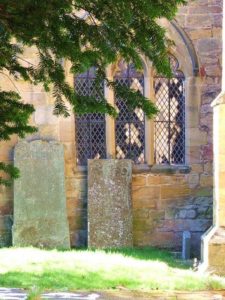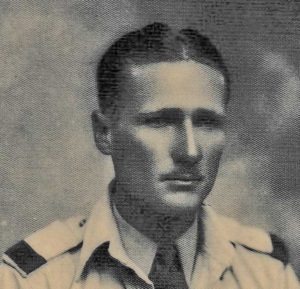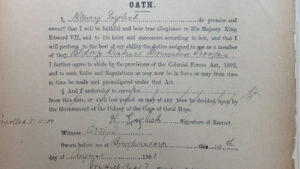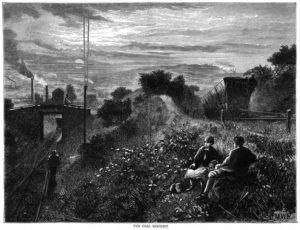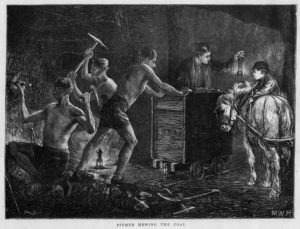We learn very little about WILLIAM’S father from the Journal, although clearly he was a great influence on WILLIAM’S early years. The first few pages of the Journal are dominated by the stories Henry tells of famous Wylam characters and incidents, which fascinated the young boy. (see William’s Early Life). While we can appreciate Henry’s love of history, it is disappointing we learn little or nothing more about him. It is also worth noting that Henry is repeating stories told by Miss Jackson. Its difficult to know what their relationship was, maybe she was just a lonely old lady sharing memories of her brother or perhaps she saw something else in Henry and fed his enthusiasm in much the same way Henry fed his son’s.
.
Henry English and mining in Durham
WILLIAM tells us Henry was born in Tow Law, but doesn’t give the year; it was 1854. He was the third child of Thomas English and Ann Ridley and grew up with his brothers William and George, first in Shotley Bridge, Tanfield, then at the Isle of Man a colliery settlement just outside the village of Stanley, Tanfield, where his sisters Margaret and Mary Jane were later born.
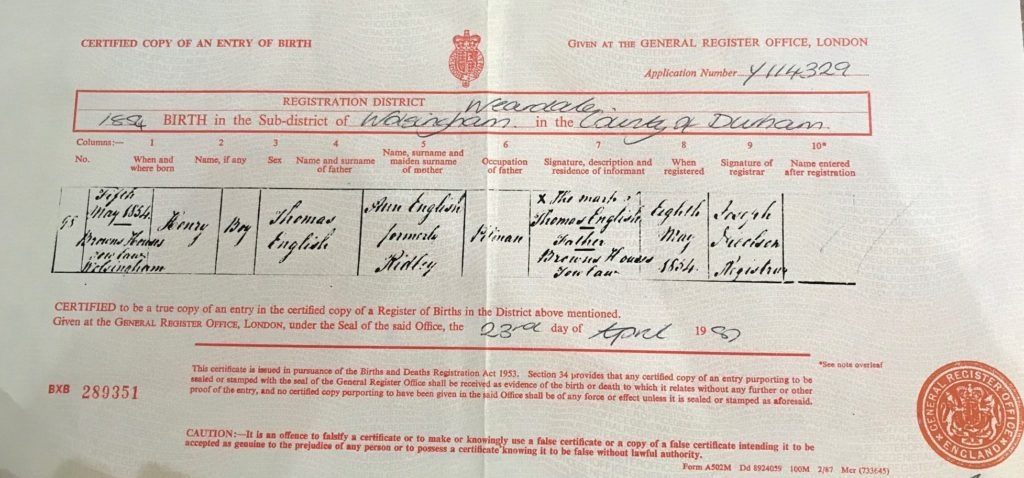
In 1866 his brother Ridley was born in Horsley, (a small village about a mile and a half north of both Wylam and Ovingham), although it is uncertain why the family were there. Henry’s future father-in-law, William Lawson, was also born in Wylam a quarter of a century earlier, but the family has not been found in the vicinity earlier than 1827.
(Later, in 1885 there appears to be a cluster of English families in the Prudhoe district close by. It would be worth exploring further, but they do not appear to be part of Henry and William’s family)
The move to Northumberland
By the age of 16 in 1870 Henry and his family were living at New Delaval, Horton, Woodhorn. He would probably have started work as a trapper, a putter or a driver, but we have no evidence. It is most likely he worked at Seaton Delaval as the family address, 10b Double Row, is in the centre of the village.
Seaton Delaval colliery opened in 1838 and rows of pit houses were built to accommodate the workers. The colliery was at the centre of many disputes during the 1840s and 50s and the pitmen were particularly vociferous on the use of blackleg labour during strikes. (Cornish, Welsh and Irish miners were all given a very hard time by the local pitmen). See note on Seghill .
Around the time the family moved there, the Seaton Delaval Coal Company opened a school and a Miner’s Institute was built. Henry remained living there with his parents Thomas and Ann, siblings William, George, Henry, (all listed as miners), and Margaret, Mary Jane, Ridley and Dorothy, scholars (Census 2nd April 1871) during which time the Miners Bond was abolished (1872), until his marriage in Ovingham in 1875.
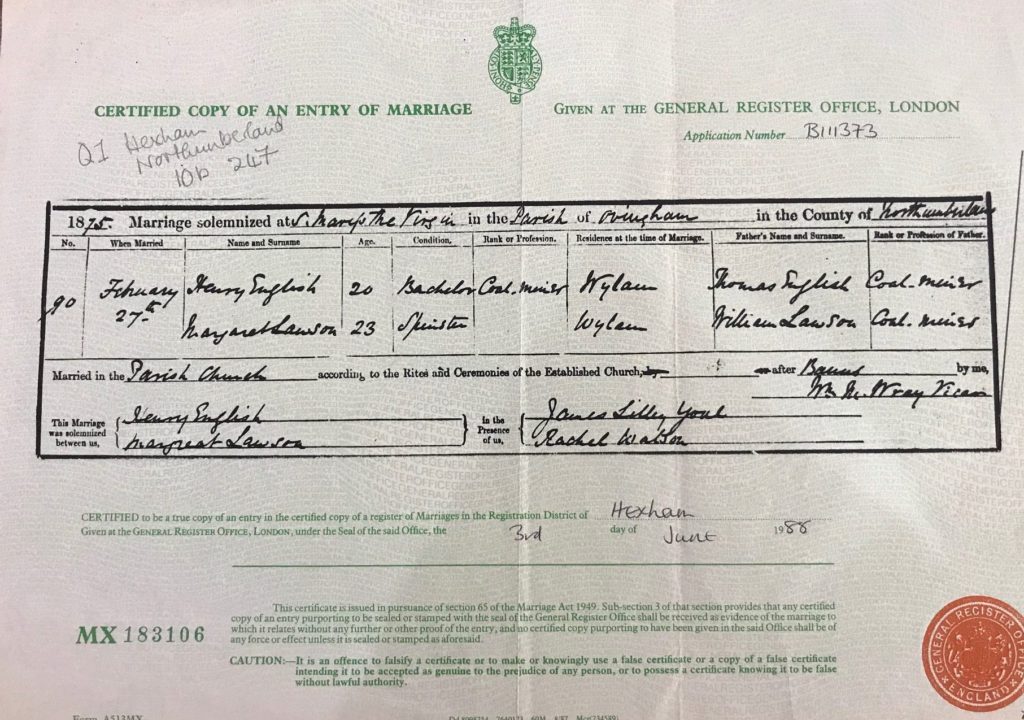
Wylam 1875 – South Africa 1896
It is clear that WILLIAM had little idea of his family’s history; he gives no information about his parents apart from his mother’s maiden name, clearly not knowing the place or date of their marriage. This however was quite common for many people at the time; very few could claim a long lineage.
Census returns, birth and marriage certificates, oral history, passenger lists etc. have been invaluable for fleshing out WILLIAM’S account, but it is still difficult to learn much about his father from what he writes in the Journal. What he leaves out also tells its’ own story.
Margaret, Henry’s wife, died in 1892 aged 40 and was buried at St Andrew’s Church, Bothal. It’s impossible to know what a devastating event this was for Henry; it seems likely that her death precipitated his urge to provide a better life for himself and his children.
The Journal tells us that in 1895 Henry signed to go to the mines in Rhodesia, but that the Jameson Raid delayed his departure. WILLIAM’S selective use of the plural ‘we’ and the singular ‘I’ in describing where he was working between 1892 and 1897 when he joined his father in the Transvaal, suggests that there were periods of time when Henry was out of the country. It seems likely he visited Southern Africa to reconnoitre before signing up.
Anglo-Boer War
WILLIAM references his father throughout the Journal from Page 2 with his description of the Stevenson centenary in June 1881 until Page 19, the beginning of the Anglo-Boer War in October 1899.
On 19th October 1899 WILLIAM joined the Kaffrarian Rifles. It seems extraordinary that he omits to mention that his father remarried on 2nd October 1899, while he was still in Krugersdorp. This information, later unearthed, is therefore all the more surprising given the bare facts WILLIAM records.
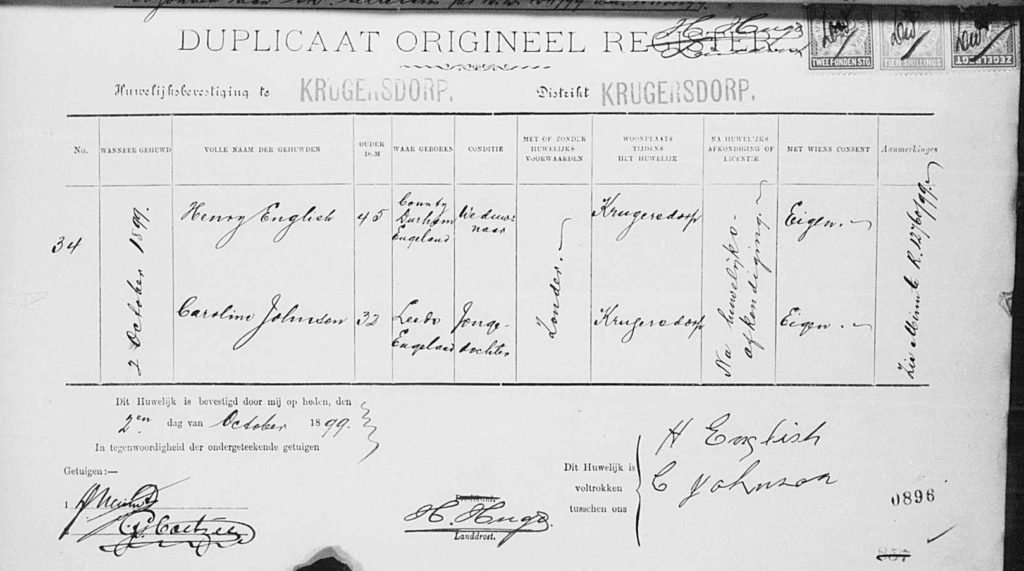
Henry’s new wife Caroline Johnson is never referred to in the Journal, but is listed as next of kin in Henry’s attestation papers .
WILLIAM left the Kaffrarian Rifles on 20 May 1901 and joined the Burgersdorp District Mounted Troop on 10 June 1901. His father Henry joined the same troop on 19 Aug 1901.
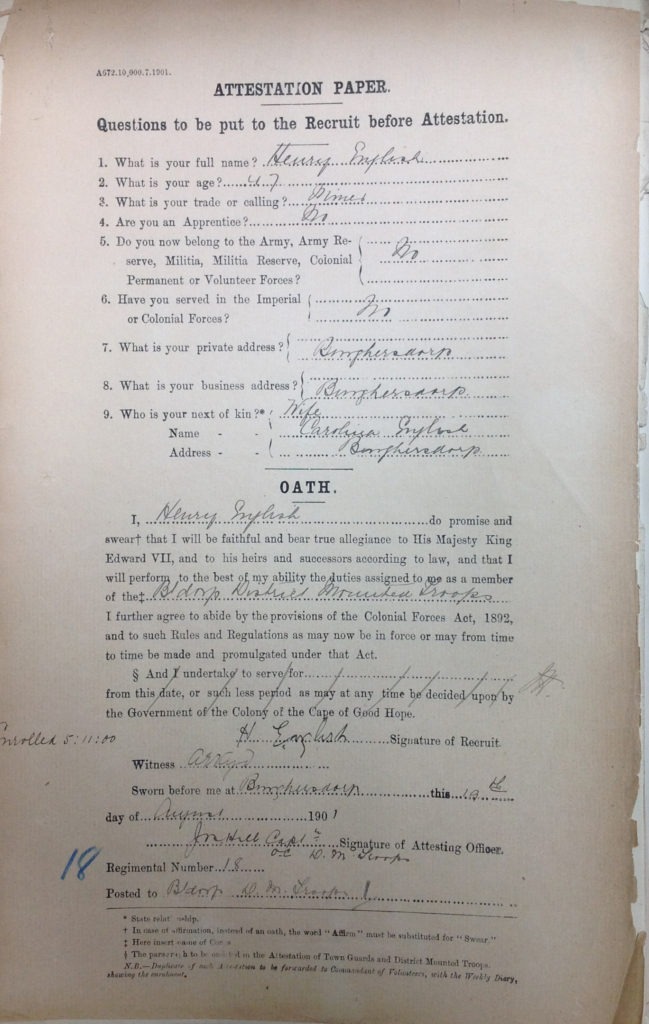
We learn in William’s poem, The Gallant DMT that Henry was in ‘this fight and had his horse shot under him’. Indeed, WILLIAM refers to The Gallant DMT poem as a ‘Satirical Piece’ and it is extremely scathing about the exploits and laziness of that particular body of men. presumably he doesn’t include his father? Apart from that passing mention Henry’s part in the Anglo-Boer War is ignored in the Journal. The Roll of Individuals Entitled to the South Africa Medal and Clasps lists Henry as entitled to the South Africa Medal. The King’s South Africa Medal was awarded to all British and Colonial military personnel who served in the Second Anglo-Boer War and who were in the theatre on or after 1 January 1902 and who had completed 18 months service in the conflict prior to 1 June 1902. Therefore it would seems that Henry was still serving in 1902.
We know how attached WILLIAM had been to his mother Margaret who died in 1892. Did his father’s second marriage upset him and cause a rift between father and son? Or, as WILLIAM seems remarkably laid back about relationships, (not even recording how he met his own wife), perhaps he’s simply too preoccupied to record it?
After the Anglo-Boer War
From the end of the Anglo-Boer War until Henry’s death in December 1908, WILLIAM only mentions his father seven further times; and four of those refer to the renewing of gun licences, both for himself and his father on 5th July 1904, 17th September 1905, 26th September and 9th September 1907. (the two 1905 entries seem to be for the same gun)
From a search of online records to attempt to find more information on Henry, the only possible snippet is a Henry English, a married man, leaving the Cape ports for Southampton on 28th May 1904 on the Walmer Castle. It is only a month after WILLIAM’S marriage. Could this be his father? If so was he going home to North East England to visit relatives? Perhaps his daughter Sarah Ann who had married Joe Shippam in 1902.
The final three references in the Journal about Henry are that he moved to Farm Sterkfontein 68 on 1st September 1908, that he finished (presumably working in a mine) on Thursday 1st October 1908 and that he died at Sterkfontein (illegible) date and was buried at Krugersdorp on 24th December. WILLIAM records that he ‘bought two young red bullocks‘ from McNab Auctioneer £15.10’ on 14th October, which probably indirectly refers to Henry at Sterkfontein Farm. He also states at the time of Henry’s death that ‘I am carrying on the farm as usual‘, which suggests that he was working alongside his father on the farm.
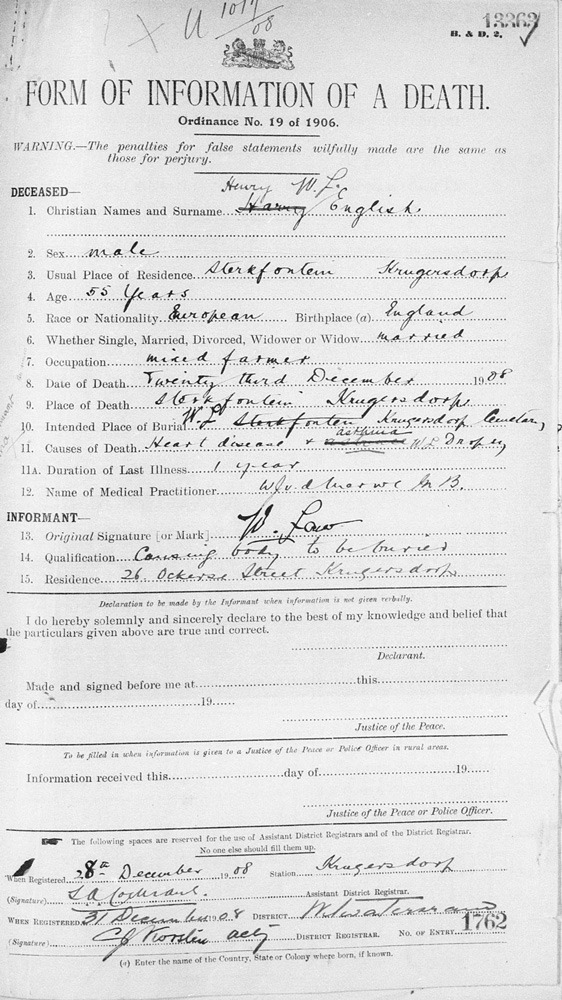
WILLIAM’s bald statement is even more shocking when the Form of Information of Death is read. Henry had been ill with a heart condition, asthma and dropsy since Autumn 1907, but WILLIAM made no mention of it in the Journal.
The closeness of the father and son’s early years has all but disappeared. It also seems likely that WILLIAM was in denial regarding his father’s illness. Joe Shippen, his brother-in-law and William Whitehead, his Aunt Mary Jane’s husband, both die from similar causes. WILLIAM must have known how vulnerable he was; perhaps it was a too painful reminder of his own mortality, but oddly enough it takes him another year, (until 23rd October 1909) before he gets round to insuring his own life and a further six months before he makes a will.
Henry had been running the farm at Sterkfontein and his occupation is given on the Form of Information of Death as mixed farmer but evidence for this has yet to come to light. Did he leave a will? Another curious fact is that Henry’s sister Mary Jane provided the inscription on Henry’s memorial stone, rather than his second wife or son.
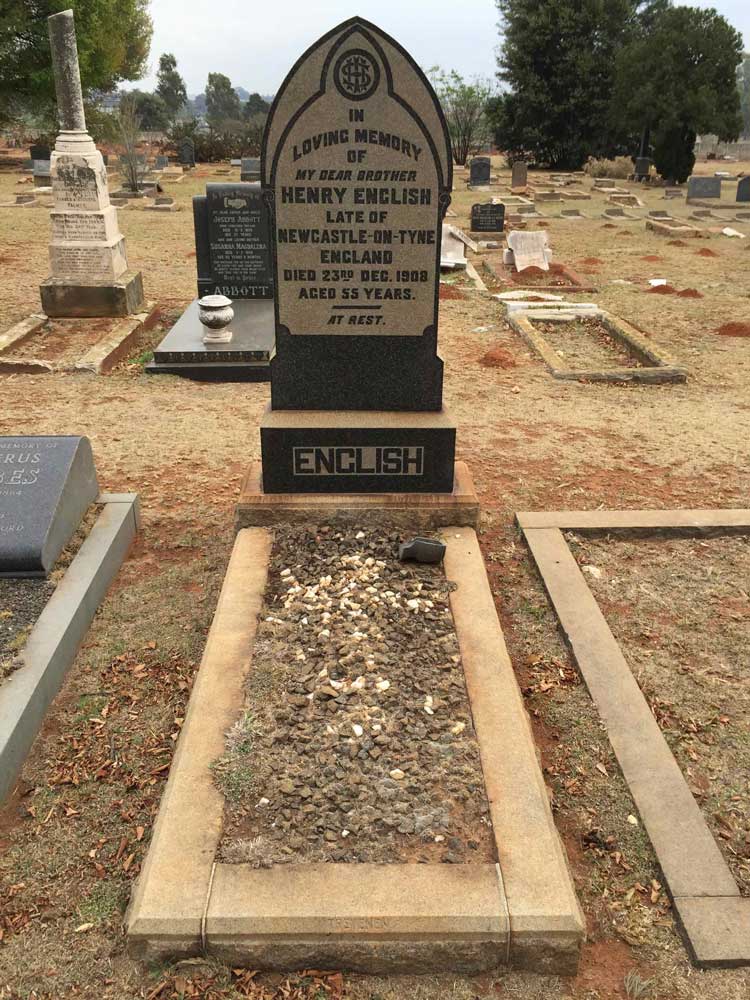
It is probably entirely predictable that WILLIAM’S own first attack of asthma is in June 1913 and his death is two years later. It is clearly not reported in the Journal on the date it occurred but retrospectively. Both father and son’s death is directly related to their work in the gold mines.
After Henry’s second marriage it is impossible to get an impression of him from the Journal. Official records provide some additional information at the the time of his death. It would be interesting to hear from any descendants of Caroline Johnson/English who may have more information to throw further light on his years in South Africa.

